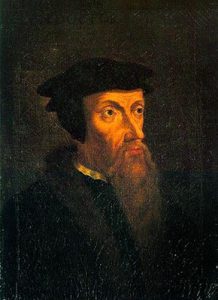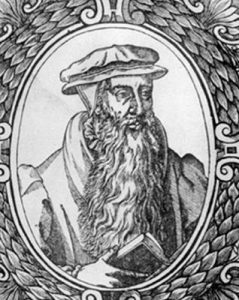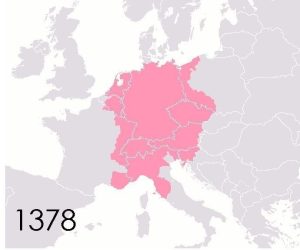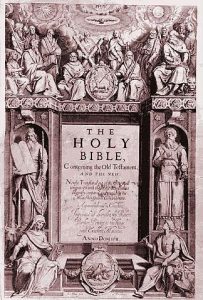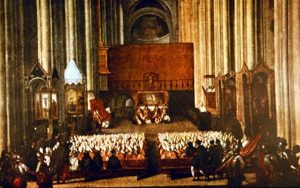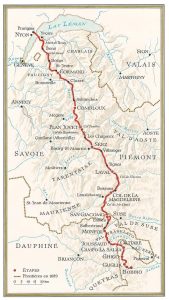The XVIth century : the Reformation came to Scotland
In the XVIth century, Scotland was an independent nation ruled by a Stewart king (they had been on the throne since 1371) and a parliament. However, since the Middle Ages, England had continually tried to impose her power north of the border and the Scots had to fight many battles in order to maintain their independence. France became an ally in 1295, giving her full support in this struggle.
The Scottish parliament passed a bill in 1560 in favour of the Reformation, which was based on the German model. It was inspired by the Scottish reformer John Knox (1514-1572), who had stayed with Calvin in Geneva after having served as chaplain to Edward VI, the young English king. When he returned to Scotland in 1559, he found a tense political climate. Marie de Guise, a catholic, was Regent, with the support of France. That same year an anti-French protestant party supported by John Knox assumed power. When Marie de Guise died the following year, the Scottish parliament decided to break with Rome and forbid the celebration of mass. John Knox and five others drew up the Scottish Confession of faith, a new liturgy, the Book of Common Order and a new book about Church government.
The Scottish reformed Church became a national Church, but it was separate from the State indeed, the sovereign was not the head of the Church as was the case for the Anglicans. John Knox, a devoted follower of Calvin, aimed at preserving the spiritual independence of the Church.
Nevertheless, the issue of the episcopacy continued to provoke trouble. Supporters of the Presbyterian model (that is to say a Church made up of local communities who delegate representatives to regional and national bodies) outweighed their opponents in 1592 and the Church of Scotland became Presbyterian. In spite of this decision the bishops were not dismissed but continued to have a seat in Parliament, although they did not really have any more power.
The XVIIth century : a Presbyterian or an Episcopal Church ?
In 1603 James VI of Scotland (1567-1625), also became the king of England under the name of James I (1603-1625) ; in this way he had authority over both united countries, although they were independent of each other until 1707. Throughout the XVIIth century, the Stewart kings tried to impose episcopalism ( a system where the Church is governed by bishops) on the Church of Scotland ; this gave rise to constant rebellion.
In 1606, James I had Andrew Melville (1545-1622) imprisoned ; he was the successor of John Knox, an enthusiastic defender of the Presbyterian system and had taught at the Academy of Geneva when beginning his career as a professor. In 1610 the king imposed a return to episcopalism on Parliament.
The conflict worsened in the reign of his son Charles I (1625-1649), who wanted to set- up the Church of Scotland on the same lines as the Anglican model in 1637 by introducing the Book of Common Prayer ; although this had been drawn up by three Scottish bishops, it closely resembled the English Prayer Book. When this new liturgy was first used in Edinburgh cathedral the congregation were furious and anger spread through most of the country. In 1638, the “national covenant” was signed by a majority of the Scots, to prevent the introduction of any new liturgy which had not been previously agreed to by the Church assemblies. At the end of the year there was a general assembly of the Church where the fourteen Scottish bishops were deposed and the Church of Scotland returned to Presbyterianism.
Charles I efforts at imposing his reforms on the Church of Scotland led to an alliance between the Scottish and English rebels : this was the beginning of the English Civil War (1642-1644) between the supporters of the king and their opponents. The rebels signed the Westminster Confession of Faith which is still used by the Church of Scotland today.
The Scots were against the execution of Charles I and proclaimed his son to be king. Known as Charles II, he was crowned in Edinburgh, after having sworn allegiance to the Presbyterian Church of Scotland. However, Cromwell’s armies won a brilliant victory over the Scots in 1650 and from then on General Monk governed Scotland under the Cromwell Protectorate.
After the restoration of Charles II, episcopacy was reintroduced in both Scotland and England : pastors who refused to co-operate were dismissed. When William of Orange and Queen Mary came to power in 1688 the situation changed and the Church of Scotland became Presbyterian once again in 1690 ; some Scots reacted to this by breaking away and setting up the Scottish Episcopalian Church, which was similar in structure to the Anglican model.
The XVIIIth century : uprisings and persecution
In 1707, the Act of Union joined Scotland and England under the name of Great Britain, in spite of opposition from many Scots. From then on Scottish representatives had seats in the Parliament of the United Kingdom of Great Britain in London until an independent Scottish parliament was re-established in 1997.
Queen Anne Stuart (1702-1714) succeeded William and Mary ; she was a fervent Anglican and protected the Scottish Episcopalians. Indeed, by the act of tolerance in 1712 she allowed them to use the liturgy in the Prayer Book. Not surprisingly, their numbers began to increase.
When she died her crown passed to the House of Hanover by the Act of Succession was passed in 1701 which excluded Catholics from the British throne. The last Stuart king, James II, had converted to Catholicism so it was not possible for him to reign ; he and his descendants had many followers in Scotland.
The uprisings in support of the Stuarts, first in 1715 and again in 1745 under the leadership of James II grandson known as “Bonnie Prince Charlie”, both came to nothing. They had terrible consequences however : the persecution of all the pastors and bishops who had refused to swear allegiance to the House of Hanover out of loyalty to the Stuarts.
The Episcopalian Church was particularly affected, with many buildings being burnt down and pastors imprisoned. In fact, this weakened the Church considerably.
The Revival movement came to Scotland at the end of the century. Many pastors and laymen, such as James and Robert Haldane traveled throughout the country, preaching in the open air, following the example of Wesley and Whitefield, the founders of Methodism.
The XIXth century ; a split within the Presbyterian Church
There was conflict over the independence of the Church of Scotland from the State ; this became worse in the first half of the century and finally there was a split in 1843. The disagreement was over the appointment of pastors. Moderate members accepted the intervention of the civil authorities in this matter, which had been voted by Parliament in London in 1707 although many Scots had disapproved of it at the time. The evangelicals, who were followers of Calvin, wanted more independence for the Church ; their leader was the pastor Thomas Chalmers (1780-1847). After ten years of struggle there was a split during the general Assembly of the Church ; 451 pastors left the established Church. By doing this, they gave up their parish, their presbytery and their stipend. They founded the Free Church and, astonishingly enough, its members managed to finance the building of more than 500 new churches, the pastors’ stipends and missionary work.
In 1874 Parliament put an end to the intervention of the civil authorities when pastors in the Church of Scotland were appointed. The Churches were not reunited, however, until the following century.
In theology, Bible criticism, which started in Germany in 1830, only came to Scotland towards the last part of the century. The division within the Church had prevented theology from progressing because the protagonists on both sides had remained traditional in their outlook and clung closely to Calvinism. In 1865, William Robertson Smith (1846-1894), a young theologian who had studied in Germany after having been at Aberdeen and Edinburgh universities, wrote an article for the “Bible” section in the Encyclopedia Britannica. He had been greatly influenced by the German school. His approach to : the origin of the Pentateuch, the authors of the Gospels, the fact that the Psalms had been written by different people, had the effect of dynamite on readers who were not used to this manner of thinking. He lost his place as professor at Aberdeen University after a trial which lasted for five years and held everyone in suspense, including the newspapers. Strangely enough, only one generation later Smith’s ideas were accepted by nearly all the members of the Church of Scotland.
The XXth century : the reunification of the Church of Scotland
It was not until 1929 that the different Presbyterian Churches were reunited to found the “Church of Scotland” (the Kirk), after an Act of Parliament in 1921, which recognized the spiritual independence of the Church of Scotland with Jesus Christ as the only leader and king. Some parishes refused to join the union and constituted small independent Presbyterian Churches but there were not many of them. The Presbyterians refused to unite with the Scottish Episcopalian Church when a project was put forward in 1980.
The first woman pastor in the Church of Scotland was ordained in 1969 – there are now more than 170 women out of 1,400 pastors in the Church of Scotland. 42 per cent of the Scots claim to belong to the Church of Scotland. The latter has more than 1,100,000 members, whereas the Episcopalian Church, part of the Anglican communion, has only 45,000 members and the Union of free Churches in Scotland (Presbyterian) has only 4,400 members.
The Church of Scotland has been part of the ecumenical movement since the missionary Assembly in Edinburgh in 1910. It is a member of the Ecumenical Council of Churches (E.C.C.) and on the local level, it is part of the movement “Action of Churches Together in Scotland”.
As it is a reformed Church, it is a member of the International Reformed Alliance, the Concorde of Leuenberg and the Conference of European Churches (the KEK).
An expanding Church in the world
Presbyterianism has developed considerably throughout the world because of the union between Scotland and England – another reason for this is the emigration of the Scots overseas. Many Scots settled in the States or Canada, especially in Nova Scotia – they even set up a Presbyterian Church.
Presbyterian missions were sent throughout the Commonwealth and after that a host of American Presbyterian missions went to Africa, Latin America and the Far East, especially in Korea, where there are now a great many Presbyterians.

